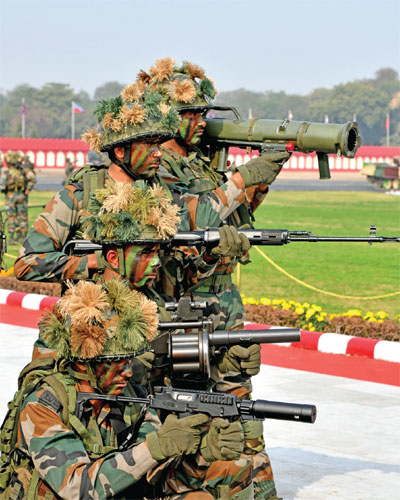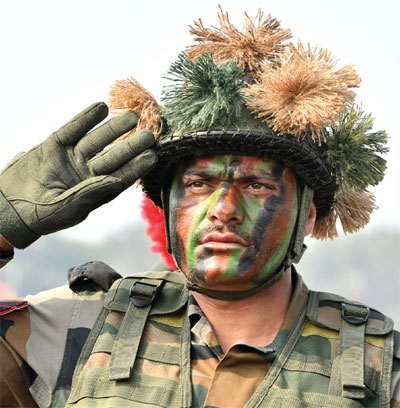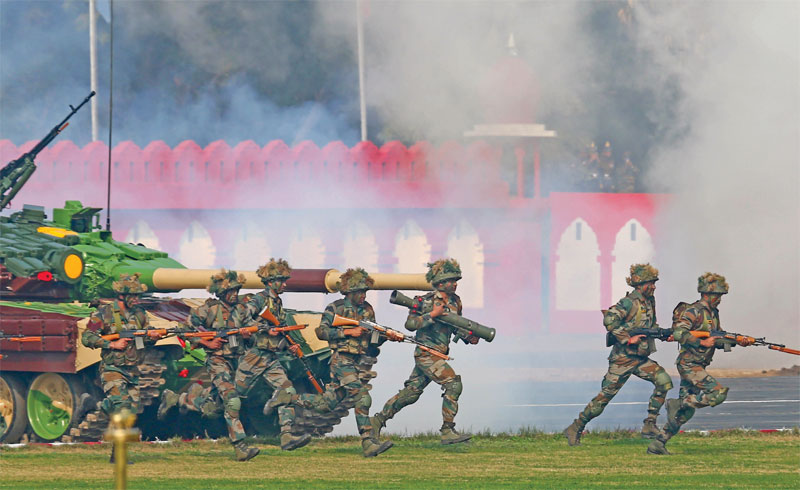Battle ready is not just the state of equipment, but training too
 Ravi Palsokar
Ravi Palsokar
The health worker in a PPE kit, a mask and protective covering on the head is an emblematic image of the present pandemic which will remain with us long after its havoc and fury have been spent.
The fireman in his shining helmet and engine (so beloved of children), and the soldier on the ground seeking protection on the battlefield, follow the same principles of maximum personal security with need to retain flexibility and agility to carry out his/ her task. The parallels continue whichever way one looks at it, but reverting to the main point, the purpose of protecting the individual is to allow him to continue to be effective without falling prey to an enemy, a deadly disease or a calamity.
The first time the criticality of personal protection was brought home to me was during operations when fighting against the LTTE as part of the Indian Peace Keeping Force in northern Sri Lanka. Encounters with the militants were not frequent but their ingenious improvised explosive devices (IEDs) were taking toll of our soldiers all the time. The incident referred to occurred inside deep jungles when a column of commandoes accompanied by their supporting Sappers were searching for a suspected hideout. A tripwire activated an IED which was an improvised Claymore mine and injured two officers and some jawans.
Many of them suffered pellet wounds in their backs because the way the IED was placed to hit individuals coming at the back rather than the front where the tripwire was placed. As a psychological tool it was deadly because no one knew who the IED would hit. In this case if these soldiers had been wearing bullet proof jackets, the numbers of injuries would have been much less. Two lessons can be drawn from this, one that in low intensity operations whether against insurgents or terrorists, encounters are infrequent but their IEDs can cause great damage and protective equipment can prove useful. In conventional war, where the conditions are different, the protective jackets serve the same purpose, but their efficacy is dependent on many other factors.
From time immemorial, the soldier has sought to protect himself while fighting. This protection has ranged from body armour, to moving in a protected vehicle such as an armoured personnel carrier or a tank. However, whatever measures are adopted they have to be compatible with allowing the soldier to use his weapon, firepower and the ability to move quickly, which is mobility. The need for protection has to be balanced between effectiveness and mobility.

weapon systems
I believe that even with optimum protection provided, the efficacy of the soldier is dependent on how skilled he is in his art on the battlefield. This consists of training, field craft and battle drills, the need for discipline, teamwork and leadership. The point being made is that while the criticality of specialised equipment cannot be denied, the importance of personal protection is dependent not only on protective clothing and transportation but also on a host of other factors related to a soldier’s trade. This is the reason why the best equipped armies in the world can be defeated in the larger sense by seemingly weaker enemies.
Personal Protection
The popular images of a soldier show him fully kitted with a bulletproof jacket with ammunition pouches on his chest, helmet on the head and rifle at the ready. If only reality would be so attractive. In fact, the soldier before an engagement with the enemy will usually be tired, sweaty, juggling with his bulletproof jacket and helmet and seeking every shelter from view and fire from the enemy, before he comes in close contact with him. Even the defender, static and protected he may well be, would be alert not to be surprised by the unexpected.
Body armour has always been in demand. Thick coat or leather jackets, chainmail suits, think of the knights in shining armour and similar images readily come to mind. However, till the World War II, bulletproof jackets were heavy and cumbersome and rarely used. It is for tasks such as bomb disposal and firefighting that individuals wore specialised clothing. Aircrew were given protection by light flak jackets and metal sheets protecting their seats. The first major development came by the discovery of Kevlar in 1965 by Stephanie Kwolek, a research chemist working for DuPont. It was a material of exceptional strength yet flexible and lightweight. It could be woven into a cloth-like material and this in turn was used to make strong tyre cord and of interest to us, bulletproof jackets. The latter was first adopted by law enforcement agencies in the US and soon thereafter by the defence forces. Modern bulletproof vests still use the same principle and research on other materials continues, but the key lies in the trade-off between protection and mobility.
This same principle applies to mechanised transport on the battlefield. The fighting tank made its appearance during World War I and its development since then has been rapid. Depending on the philosophy adopted by the armies of various countries, firepower, mobility and protection are given more or less importance. The development of the armoured personnel carrier and its natural corollary, the Infantry Combat Vehicle has facilitated its use to transport infantry on the battlefield. The question remains, you may give a soldier all that he needs and yet his effectiveness is dependent on his individual skills on the battlefield. Is this really such a decisive factor? Experienced soldiers will agree that it is so. (Note that throughout this article, the word soldier is used in a generic sense to denote soldiers, sailors and airmen and in today’s time include both male and female combatants).
Start with personal protection. This is directly related to the efficacy and capability of the adversary’s weapons. In recent times, there has always been a debate whether personal weapons such as rifles, carbines and light machine guns should use heavy calibre ammunition that kills or conversely, incapacitates. This is an unending debate which we need not enter. However, personal experience shows that it is the intensity of the fighting which differs from counter-terrorism or counter-insurgency operations to conventional war which really matters and protection provided makes the difference between survival or otherwise on the battlefield. I have an enduring memory of a helmet peppered with bullets fired from a 5.56mm calibre rifle. The lucky soldier who survived this burst suffered nothing more than a headache. But if the burst had been just a few inches lower, then it would most likely have killed him. This signifies that body armour is useful, but its effectiveness cannot be guaranteed.
The same argument applies to transportation, particularly of the infantry. Whatever the means of transportation into battle whether by soft vehicles or personnel carriers and the like, the infantry has to dismount and close with the enemy. They may overrun a position in their combat vehicles but to occupy what they have captured; the foot soldier has to dismount. In this case the tanks are at an advantage because they can only fight mounted, and this offers them protection. However, anti-armour weaponry has been getting stronger each time and as a result, the armoured protection is adequate till it is not! That is why tanks and their crews get destroyed in battle. The cover provided by the combat vehicle has one major advantage which is that in a nuclear environment, the troops are not directly exposed to radiation and can transit through contaminated areas. However, the environment remains lethal, and soldiers need additional personal protection of NBC suits.
Other Protective Measures
All military operations are undertaken as a team and hence teamwork is of primary importance. This covers a gamut of a soldier’s skills which allow an individual to work as a part of a team to maximise his effectiveness. Easier said than done! Let us examine some of the main qualities.

Start with field craft and battle drills. In essence, field craft is the use of ground for taking advantage of the terrain configuration and cover available. Some terrain may be constricted such as forests or thick cover or may afford many folds in the ground which can be taken advantage of. All combat soldiers will immediately recognise that this applies to deployment of all arms and support services. Tanks that expose themselves when moving or deploy without due care are liable to be spotted and destroyed by the enemy at increasingly longer ranges; artillery guns have to be deployed so that they get maximum protection of the configuration of the terrain. Modern vision devices for both day and night expose the battlefield like never before and modern communications allow passage of information and orders to a degree that was not available earlier. Thus, individual units and formations are increasingly exposed to the adversary’s scrutiny. This is a two-way street, but enhanced technology will give added advantage to the side that exploits this better.
Relate this to battle drills. What this means is that in the confused scenario on the battlefield every individual knows what his task is and how he is expected to achieve it despite lack of information or orders. This ensures that there is no looking over the shoulder to ask what should be done next. Once again it is easy enough to say this should be done but it is another matter that it is done competently. Individual skills such as marksmanship, utilising one’s weapon and equipment to obtain the most out of it comes from practice and training. So prior preparation or training matters when the battle is joined. ‘The more you sweat in peace, less blood you spill in war’ is an aphorism whose importance cannot be minimised. Professional soldiers would call this ‘old hat’, but its necessity cannot be denied and this in turn has to be adapted to ever changing conditions on an increasingly hi-tech battlefield.
Summarising so far, it can be said that while protection is essential, it is not just personal protection that is of consequence, but also collective measures and has to take an overall view as to how the soldier is projected into battle, the task given to him and the management of the battlefield.
Other Contributory Factors
Often in operations we hear of troops suffering unnecessary casualties. It is not bravery alone that is the reason but a host of other factors such as poor training, a faulty plan, poor tactics, being surprised by the enemy and poor leadership which results in lack of motivation coupled with inadequate or delayed medical treatment and so on. The point is that there are circumstances when all these factors come together to produce a unit or a formation that is successful or otherwise. A simple example, an impossible task will invariably result in failure and more often, unnecessary casualties. At whose feet should the blame lie, the commander who gave the order in the first place or the troops who failed to carry it out? These factors need examination as we look at the necessity for protective clothing and equipment.
Start from the lowest level. The untrained soldier is next to being useless on the battlefield. He cannot fire his weapon or hit the target and is as much a menace to his colleagues as is the enemy. On the other hand, a well-trained soldier is a superb fighting unit on his own, compensating for many deficiencies. This applies mainly to the infantry because other arms fight as teams whether they be tank crews, artillery gun crews or Sappers sub-units. The trained soldier then has to fit into his sub-unit, the section, platoon or a rifle company. This is not a plug for infantry but it is an inescapable fact that once an individual hits the ground under enemy fire, he is not only alone but has to overcome his fear and depend on his mates to move forward and close with the enemy. If there are casualties and there will be, then he has to take on more than his share often on his own initiative.

Similarly sub-units support each-other and units will often have to undertake an operation to help a fellow unit achieve its task. In all types of operations, this is the role of the reserves. A real incident will serve to illustrate this. In the jungles of northern Sri Lanka, units and their sub-units had perforce to be deployed at a distance from each other. In one case, a rifle company at the farthest end of the operational area found itself in a difficult situation. They were too far from their battalion headquarters to be in radio communications and were in intermittent contact with the nearest company post which was good three-four hours march away. Luckily, the nearest company commander heard the firing at a distance and realised that he was the only one who could help immediately. Without waiting for any orders, he decided to move out to help and informed his unit headquarters accordingly. This set in motion a series of actions which lasted over the next few days resulting in a setback for the LTTE. Consider, it is the initiative of one officer that the whole operation could be undertaken to a successful conclusion. Needless to say, this was training, teamwork and leadership at its best. One can recount many such examples and when such reaction was absent, failures too. Leadership plays a major role in this.
Leadership
In the final analysis, everything boils down to leadership. However, the best of leaders have to contend with the intensity of the fighting, the criticality of the area which is being fought over in the sense that it may be vital ground for both the defender and the attacker and similar reasons. The point is that every good leader will try and ensure that his plan is carried out with the minimum of casualties to own troops and maximum damage to the adversary. The men under command appreciate and recognise this and this in turn impacts morale. Once casualties do take place, speed of evacuation and early provision of essential medical aid have to be built into planning and preparation.
This article is not about leadership, but two points need underlining. In recent times there is far too much emphasis on centralised control which leaves little latitude to subordinate commanders, particularly at the section and platoon level. Consider this. During the Sri Lanka operations, I once had occasion to find fault with the fire discipline of two sub-units. I asked why the section commanders could not control the seven or eight men under them. I was cut short by an irate NCO who asked whether we allowed him to exercise his command in peacetime. He had put his finger on the nub of the problem. The need for delegation was never better made. The other point relates to senior leadership. My own experience is that we confuse supervision with leadership. It is not enough for a senior commander to find faults and point out lacunae and leave. He has to see them corrected and where necessary, provide the wherewithal to do so. This may be in terms of reinforcements, equipment both general and specialised and also moral leadership. Suffice it to say that men will give their best when they are confident about their leaders.
Conclusion
This article has made an attempt to link the subject of personal protection of an individual to a larger issue of his capability on the battlefield. In this, protective clothing and equipment is just one factor. The Indian jawan and his junior leader is rightly famed around the world for bravery and dedication to duty. It is the task of his superiors that he is launched into battle fully prepared and duly cared for—before and after.

